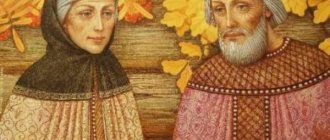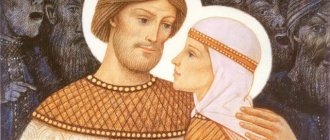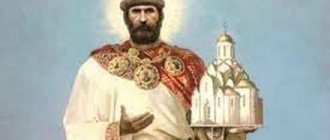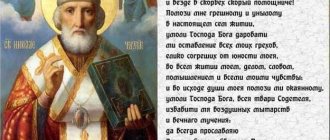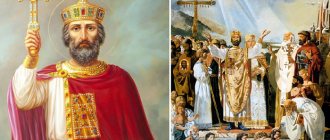- Summary
- Various authors
- The Tale of Peter and Fevronia of Murom
The story about Peter and Fevronia of Murom begins with the author telling what city will be discussed. The story began in the city of Murom. Pavel reigned there. He had a wife. The tempting serpent began to come to the prince’s wife. Only he came not in his own guise, but in the guise of Prince Paul. The prince's wife did not remain silent and told Pavel everything. Then the prince began to think about how to kill the snake. He ordered his wife to ask him, while enjoying the serpent, why he was destined to die. The prince's wife did just that.
It turned out that the tempting serpent was destined to die at the hands of Peter and Agrikov’s sword. Then Pavel told the whole story that was happening with the prince’s wife to his brother, whose name was Peter. In turn, Peter realized that he needed to find a sword. And then he went in search of him. Having found the sword, he still killed the tempting serpent. While he was cutting the serpent, his blood poured onto Peter, and he was covered all over with sores.
Then Peter began to look for doctors who could cure him. But there were no such people in Murom. Then he went to the village of Laskovo. There the servant came across a house where a girl named Fevronia was sitting. After the conversation between the girl and the servant, the latter handed everything over to Peter. Fevronia promised to cure Peter if he took her as his wife. But he did not want to marry the tree frog’s daughter. However, Peter was amazed by Fevronia's wisdom. Having done everything she said, he was indeed cured of his illness, but due to the fact that he did not take the poison dart frog’s daughter as his wife, the ulcers on his body reappeared.
For the second time, Peter went to Fevronia so that she could cure him. Then he really took her as his wife. After the death of his brother, Peter began to rule the principality together with Fevronia. And no matter how people asked, Peter never abandoned his wife.
At the end of the story, the author says that Peter and Fevronia died on the same day. They were buried in coffins carved from stone, which were connected by a thin strip.
A very brief retelling of “The Tale of Peter and Fevronia of Murom” by Ermolai-Erasmus the Prereshny
The story takes place during the reign of Prince Paul, whose wife the snake tried to tempt. The woman was able to find out that only Peter could kill the snake using Agrikov’s sword.
The prince had a brother Peter, who kills the snake, but receives incurable injuries. As a result, the sick Peter is cured by Fevronia, in exchange for him taking her as his wife. But the man does not want to marry the tree frog’s daughter and decides to buy her off with expensive gifts, which Fevronya does not accept.
After leaving for Murom, Peter fell ill again and was forced to return to Fevronya. The girl cures him again, then Peter marries her. After Paul's death, Peter becomes prince.
The boyars do not like Peter's wife because of her low origin. They set a condition for the Prince that Fevonia should be expelled from Murom, but Peter leaves with his wife, abdicating the throne.
After their departure, riots begin in Murom. Then the nobles find Peter and Fevronia and ask them to return to the city and rule as before. The prince and princess return to Murom.
They are characterized as fair and wise rulers, they host strangers, feed the hungry, give clothes to the needy, and save the poor from misfortunes.
The prince and princess became monks, changed their robes to monastic ones, and took the names David and Euphrosyne.
After death, the saints were buried together near the Church of the Nativity of the Holy Virgin.
The couple were examples of Christian marriage and were canonized for their piety and mercy.
Chapter Three
The prince's brother died. Therefore, Peter became the sole ruler. Fevronia was not accepted for the reason that she was not of noble birth. The boyars even offered the prince to take another woman as his wife. And send Fevronia back, giving her as much wealth as she wants. The prince asked them to voice their request to Fevronia herself.
She promised them that she would fulfill their request, but only on the condition that the prince leave with her. The boyars were not very upset, because they had long dreamed of taking his place.
The prince decided to adhere to God's commandments, so he left with Fevronia. When they were crossing the river in ships, one of the men wanted to get closer to Fevronia. But she very wisely gave him a lesson. After this, he realized that she had the gift of foresight.
The prince was saddened that he had made such a hasty decision. But Fevronia reassured him, saying that God would not abandon them in trouble.
In the morning the boyars came to them, begging them to return and continue to rule the city of Murom. It turns out that there were too many people who wanted to become rulers, so they killed each other. Prince Peter and Princess Fevronia agreed to return.
For a long time they ruled without violating God's commandments and helping everyone in need.
List and brief characteristics of the heroes of “The Tale of Peter and Fevronia of Murom”
The main characters of “The Tale of Peter and Fevronia of Murom”:
- Fevronia is a princess, the wife of Prince Peter. She is a hardworking, wise girl with folk knowledge.
- Peter is the ruler of Murom, an honest and kind man. He rules with prudence and good words, and does not use rage and anger.
Minor characters of “The Tale of Peter and Fevronia of Murom”:
- The serpent is the enemy of Paul's family and the tempter of his wife, sent by the devil himself.
- The boyars are the nobles of Murom, thirsting for power and trying to take the throne.
- Pavel is the elder brother of Peter and the Prince of Murom, whose appearance takes the form of a snake.
Memory
The grave was located near the Church of the Virgin Mary. Under Soviet rule, the relics were transferred to the museum, and the Cathedral was destroyed. The shrine was returned to the Church in 1989. Now a particle of the relics, along with the icon, is in the Moscow Church of the Ascension. There are weekly services dedicated to these saints. Part was stolen in 2012. Another part is located in the Murom Monastery. There is a never-ending flow of pilgrims who ask Peter and Fevronia for recovery and family well-being. The legend about their life still lives, although so many years have passed.
Peter and Fevronia Day
- According to the old style, the holiday was celebrated on June 25.
- Now, according to the new style, their memorial day is celebrated on July 8. It was then that their relics were transferred to the Nativity Cathedral, and the holy spouses died in April. For the Slavs, mowing and swimming began on July 8th. Before him, it was impossible to enter the water without looking back. It was believed that mermaids lived on the shore. Saints were already revered then, and due to the coincidence of the two holidays, the day was called Fevronia the Rusalnitsa.
- September 19 is also considered their holiday in memory of the transfer of the relics in 1992. This holiday is intended for those who would like to get married on the day of these saints, since July 8 falls on the Fast of Peter the Great, and only engagements took place on this day.
Monuments
After the approval of a national holiday in honor of the saints, monuments are erected to them as a reminder of the example of an ideal marital relationship. They are often visited by those getting married. The opening of monuments usually occurs on July 8th. Such a large number of sculptures are not dedicated to any other Orthodox saint.
Relationship to history
In 2008, on the initiative of Murom residents with the assistance of Svetlana Medvedeva, the Day of Remembrance of Saints became an official national holiday.
This holiday is a Russian alternative to Valentine's Day on February 14th. The symbol is chamomile - such a simple, sunny and beloved flower. Also, July 8 is Murom City Day. Despite this, some consider the story hypocritical and based on blackmail. But if you read it carefully, you can see that the Lord brought the paths of the saints together. Fevronia was a seer and knew that life with Peter was destined for her by God. And indeed, the saints lived pious lives, helped many people, and sincerely loved and supported each other. This is what should be the basis of any happy and strong family.
Summary of “The Tale of Peter and Fevronia of Murom” in detail by chapter
The legend is divided into 4 chapters, sequentially telling about events in the lives of the saints.
Chapter 1
The legend begins from the moment when the city is ruled by the Murom prince Pavel. The devil sends a winged serpent to tempt. He appears before the princess in the guise of her husband. As time passes, the woman manages to suspect something is wrong. She tells Pavel about what happened. He asks his wife to find out how to defeat the snake. The woman, with the help of flattery, learns that only Peter can kill him, using Agrikov’s sword.
Peter was the prince's younger brother. He was ready to fight the serpent, but he did not have the necessary sword. One day a man went to the Church of the Exaltation of the Honest and Life-Giving Cross to pray. There Peter met a boy who offered to look at Agrikov’s sword. Peter agreed and followed the boy. Peter saw the sword lying in the crack of the stone and took it out. As a result, the main character gets the opportunity to help his brother defeat the tempter. Peter is waiting for the right opportunity when the serpent will appear again in the form of his brother.
When the right moment comes, Peter kills the tempter with the help of Agrikov's sword. But before death, the snake takes on its usual appearance and sprinkles the hero with its blood. As a result, multiple incurable ulcers begin to appear on the man’s body. No doctor can help a sick person.
Chapter 2
Peter goes to Ryazan land in the hope of being healed. Upon arrival, the prince sends servants to search for doctors. One of his servants comes into the house of a girl named Fevronia. He tells her about Peter's illness and asks about a doctor who can cure the disease. Fevronia asks that the prince be brought to her and says that if he shows sincerity and humility in his words, he will get better.
Peter promises the girl generous gifts if she can cure him. But Fevronia asks for a different payment. If Peter recovers, he will marry her. The man pretends to agree to such a condition. Fevronia gives the servant leaven based on bread and orders him to smear it on the prince’s ulcers, with the exception of one.
The next morning Peter was absolutely healthy. But he did not want to marry the dart frog’s daughter, but decided to thank her with generous gifts. They were not accepted by the girl. After Peter went to Murom, he fell ill again and his body began to be covered with many ulcers. He returns to Fevronia and she heals him again. After this, Peter decides to marry the girl.
Chapter 3
After the death of his elder brother, Peter rules Murom. The boyars do not like Fevronia because of her low origin. They constantly slander Prince Fevronya. Some time later, their patience runs out, and the boyars decide to openly declare to Peter that they do not want to see Fevronia as a princess. They put the prince before a choice: if he wants to continue to rule, he must marry another girl. Fevronia must be expelled from Murom. The princess agrees to leave the city and go home, but wants her husband to go with her. Peter also did not want to be separated from his wife. The prince voluntarily abdicates the throne, which cannot but please the boyars who are hungry for power.
The couple sails away from Murom along the river. After they set up a camp, the Murom boyars find them and begin to ask them to return to rule the city again. Since Murom, as a result of the struggle for power, many nobles who dreamed of the princely throne were killed.
The prince and princess return and rule the city again. They are characterized as fair and wise rulers, they host strangers, feed the hungry, give clothes to the needy, and save the poor from misfortunes.
Chapter 4
Having grown old and feeling the approach of death, Peter and Fevronia began to pray to die together. The couple wanted to be buried in coffins made of one stone, with only a thin partition. The prince and princess became monks, changed their robes to monastic ones, and took the names David and Euphrosyne.
The princess began to embroider the faces of saints for the Church of the Virgin Mary. Her husband sent a messenger for her, who said that his time had come to go to another world. Fevronia finished the embroidery and went to Peter. They prayed and God took their holy souls.
After the death of the spouses, they wanted to bury them in different places and put them in different coffins. But the next morning, when people came to bury them, they saw that the bodies had disappeared. They were found in the same coffin, in which Peter and Fevronia bequeathed to bury themselves. After which no one dared to disturb the bodies again, and they were buried near the Church of the Nativity of the Holy Virgin.
Part one
Prince Pavel lived in the city of Murom with his wife. And everything was fine with them until the snake got into the habit of coming to his wife. Yes, it was not a simple serpent, but a tempter. She saw him for real, while the rest of the residents saw him as a prince and did not suspect anything. The woman struggled with this for a long time, but one day the snake finally achieved what she wanted.
The woman told her husband everything. The prince thought for a long time about how he could kill the snake. And he came up with this: the woman needed to find out from the serpent where his death was kept. She did not hesitate for a moment, so she immediately began to fulfill the request. The snake, who was still a deceiver, but he believed the woman. And he said that he would die from the shoulder of Peter and Agrikov’s sword.
The woman told all this to her husband, who had a brother, Peter. The prince immediately rushed to him for help. When Peter found out everything, he agreed to help. But he could not understand what Agrikov’s sword was.
One day, when Peter went to church, a young man approached him and showed him Agrikov’s sword. Prince Peter immediately took it to fulfill his plan.
One day Peter came to visit his brother. After sitting with him for a while, he went to his wife. But there he also saw his brother. Peter could not understand what was happening. He returned to Pavel and told him everything he had seen. They realized that it was the crafty serpent trying to confuse them. Then Peter ordered his brother not to leave his chambers, but he would go and kill the snake.
Peter boldly went to the chambers of his brother’s wife and killed the serpent. But when he died, he sprinkled the prince with blood. After this, Peter began to have wounds all over his body, for which he could not find a cure from anyone.
Briefly about the history of the creation of the work “The Tale of Peter and Fevronia of Murom”
The legend was written in the 40s of the 16th century, but the appearance of the legend dates back to a much earlier period.
The Tale of Peter and Fevronia of Murom was created on the eve of the canonization of the miracle workers from Murom in 1547. The work glorifies Saints Peter and Fevronia and talks about the power of love and fidelity, as well as faith in God’s providence. The story was written by Ermolai-Erasmus the Prehreshny (a famous publicist in the era of Ivan the Terrible), who took the texts of church services and oral traditions as a basis.
The story has several versions, preserved in a large number of copies. The generally accepted version turned out to be the text that has survived to this day in the list of Pogodin’s collection. Although the author’s version of the story has hardly survived, and the manuscripts of Ermolai himself ended up in the Solovetsky Monastery in the 16th century, it is reliably known that the texts of the story are inextricably linked with his name.
Moral of the piece
This fairy tale is not just an incredible story. It says that one does not betray one's neighbors. This is a terrible sin that will definitely be punished. You should also give up lying - cunning is good, but in moderation. But deceiving, especially honest and bright people, is a disgusting decision.
The legend also emphasizes that those below the poverty line should not be denied. It is important to support them. And God's rules must really be respected. Incredible powers will then protect believers even after death.
And most importantly, you cannot pursue only selfish goals in life. Many people could die because of them. This is well illustrated by the example of the dissatisfied boyars from the work. Under any circumstances, it is important to remain honest and kind people!




